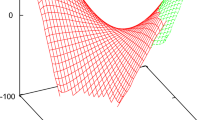Abstract
In this paper, we explore the field propagator with a structure that is general enough to encompas both the case of newly-defined mass-dimension 1 fermions and spin-1/2 bosons. The method we employ is to define a map between spinors of different Lounesto classes, and then write the propagator in terms of the corresponding dual structures.
Similar content being viewed by others
Data Availability
Data sharing not applicable to this article as no datasets were generated or analysed during the current study—the article describes entirely theoretical research.
Notes
It is important to remark, if one take into account a more specific framework, like the adjoints defined in [1, 9], thus, we may set the following relations
$$\begin{aligned} {\mathop {\lambda }\limits ^{\lnot }} = [\Xi _{\lambda }\lambda ]^{\dag }\eta _0{\mathcal {O}}_{\lambda } \quad \text{ and }\quad {\mathop {\psi }\limits ^{\lnot }} = [\Xi _{\psi }\psi ]^{\dag }\eta _0{\mathcal {O}}_{\psi }, \end{aligned}$$(31)in which the \({\mathcal {O}}\) operator holds important physical information regarding the spin-sums. Thus, a more involved amplitude of propagation may emerge as
$$\begin{aligned} {\mathcal {A}}_{{\textbf{M}},\Xi }(x-x^{\prime })= & {} [{\textbf{M}}{\mathcal {A}}(x-x^{\prime }){\mathcal {O}}^{-1}_{\lambda }\eta _0\Xi _{\lambda }^{\dag }{\textbf{M}}^{\dag }\Xi _{\psi }^{\dag }\eta _0{\mathcal {O}}_{\psi }]_{_{particle}}\nonumber \\{} & {} \pm [{\textbf{M}}{\mathcal {A}}(x-x^{\prime }){\mathcal {O}}^{-1}_{\lambda }\eta _0\Xi _{\lambda }^{\dag }{\textbf{M}}^{\dag }\Xi _{\psi }^{\dag }\eta _0{\mathcal {O}}_{\psi }]_{_{{anti}{\text {-}}{particle}}}. \end{aligned}$$(32)However, for the purposes of this work, we will not investigate this case further.
Where the sub-index Ah-7 means Ahluwalia class-7 spinors.
References
Ahluwalia, D.V.: The theory of local mass dimension one fermions of spin one half. Adv. Appl. Clifford Algebras 27(3), 2247–2285 (2017)
Ahluwalia, D.V.: Mass Dimension One Fermions. Cambridge University Press, Cambridge (2019)
Ahluwalia, D.V.: Spin-half bosons with mass dimension three-half: towards a resolution of the cosmological constant problem. EPL (Europhys. Lett.) 131(4), 41001 (2020)
Ahluwalia, D.V.: A new class of mass dimension one fermions. Proc. Roy. Soc. A Math. Phys. Eng. Sci. 476(2240), 20200249 (2020)
Ahluwalia, D.V., Lee, C.-Y.: Spin-half bosons with mass dimension three-half: evading the spin-statistics theorem. Europhys. Lett. 140(2), 24001 (2022)
Brauer, R., Weyl, H.: Spinors in \(n\) dimensions. Am. J. Math. 57(2), 425–449 (1935)
Crumeyrolle, A.: Orthogonal and Symplectic Clifford Algebras: Spinor Structures, vol. 57. Springer Science & Business Media, Berlin (2013)
da Silva, J.M.H., Rogerio, R.J.B., Quinquiolo, N.C.R.: Spinorial discrete symmetries and adjoint structures. arXiv:2203.02065 (2022)
Lee, C.-Y.: Fermionic degeneracy and non-local contributions in flag-dipole spinors and mass dimension one fermions. Eur. Phys. J. C 81(1), 90 (2021)
Lounesto, P.: Clifford Algebras and Spinors, vol. 286. Cambridge University Press, Cambridge (2001)
Rogerio, R.J.B.: Constraints on mapping the Lounesto’s classes. Eur. Phys. J. C 79(11), 929 (2019)
Rogerio, R.J.B.: Spin-half fermions endowed with bosonic traces-towards phases and classes. EPL (Europhys. Lett.) 134(6), 61001 (2021)
Rogerio, R.J.B., Aguirre, A.R.: Spin-half bosonic classification. EPL (Europhys. Lett.) 134(1), 11001 (2021)
Rogerio, R.J.B., da Silva, J.M.H., Villalobos, C.H.C.: Regular spinors and fermionic fields. Phys. Lett. A 402, 127368 (2021)
Author information
Authors and Affiliations
Corresponding author
Additional information
Communicated by Uwe Kaehler.
Publisher's Note
Springer Nature remains neutral with regard to jurisdictional claims in published maps and institutional affiliations.
Appendix A: Some Results Based on New Dual Definitions
Appendix A: Some Results Based on New Dual Definitions
Quite recently, some new definitions of dual structure opened windows to a new interpretation of how spin-half bosons emerge (from Dirac spinors) and also how they evade the spin-statistic theorem [5]. As claimed, the new dual structure furnishes a local and Lorentz-invariant theory and also provide a positive-definite Hamiltonian. Such aforementioned features are carried by a new dual structure, which reads
in which \(s=1\) stands for fermionic field and \(s=-1\) stands for bosonic field. Bearing in mind the dual definition in (A1), the spin sums (8) and (9) are now replaced by the following set
With these new results at hands, Eq.(34) is written, accordingly [5, page3], as
According to the type of field, the statistic will be dictated by the s parameter. If the field is to be fermionic, \(s=1\), forcing the anticommutative relations among the creator and annihilator operators. If the field is bosonic, \(s=-1\), and commutative relations must be taken into account. For more details, we refer to [5].
Now, following the very same steps as in Sect.(3.1), and bearing in mind the correct relation among the creator/annihilator operators as well as the value of s, the above amplitude of propagation yields
as expected for Dirac fermions and also for spin-half Therefore, we show the similarity of both results presented in [3] and [5].
Rights and permissions
Springer Nature or its licensor (e.g. a society or other partner) holds exclusive rights to this article under a publishing agreement with the author(s) or other rightsholder(s); author self-archiving of the accepted manuscript version of this article is solely governed by the terms of such publishing agreement and applicable law.
About this article
Cite this article
Rogerio, R.J.B., Fabbri, L. Propagators Beyond The Standard Model. Adv. Appl. Clifford Algebras 33, 39 (2023). https://doi.org/10.1007/s00006-023-01287-7
Received:
Accepted:
Published:
DOI: https://doi.org/10.1007/s00006-023-01287-7



